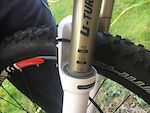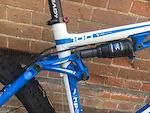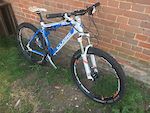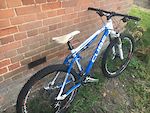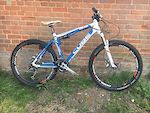MJT59
- Member since Jul 27, 2015
- 65
-
 Bury St Edmunds , United Kingdom
Bury St Edmunds , United Kingdom - 1 Followers
- 0 Trailforks Points
Recent

MJT59 mattbeer's article
Nov 12, 2021 at 8:47
Nov 12, 2021
First Look: Lal Bikes' Supre Drivetrain Splits The Derailleur In Half Before It Happens On the Trail
Clever, clever, clever. What a star this guy is. If it looks right, it probably is right. He has done excatly the right thing: simplified mech, placed it out of harms way. We still have to put up with telescopic forks in spite of tremendous innovation like Structure, so I do hope the ultra-conservative industry dont do their usual thing and shove this under the carpet.

Selling
Apr 13, 2020 at 11:42
Apr 13, 2020Cube AMS HPA 120 Medium
$300 GBPCube AMS HPA meduium with Reba Race 120mm forks with RP23 rear shock 100mm traveal at rear. SRAM transmnission. DT Swiss 26" wheels and hubs. Avid Eliir R brakes. Schwalbe Nobby Nic 2.4 front and rear. Well cared for bike, a few stone chips, careful rider (no bent rims), older rider, one owner. Unridden for three years or so. The only change made has been new grips and slightly shorter stem, but still have the old Syntace stem.

MJT59 dan-roberts's article
Mar 13, 2020 at 5:39
Mar 13, 2020
Behind the Numbers: The Grim Donut
Almost forgot to say: This article annoubces itself as thinking outside the box, but the reality is this is an article about chasing one dimension, the fork rake angle reduction. Nothing new in that and the results are fairly predictable. Thinking outside the box would be something like asking how to increase the fork and angle, or perhaps asking what is the ideal trajectory for the front wheel for the type of riding intended, or even, dare I say it, how can I increase front wheel grip using suspension? After all is said and done, grip translates to time. I am going to tear my hair out the next time I read words like "progression" and "support" in an article about suspension. Get the stop watch out please.

MJT59 dan-roberts's article
Mar 13, 2020 at 5:12
Mar 13, 2020
Behind the Numbers: The Grim Donut
What a waste of time and money and people. Is it April 1st yet? Once again the rear end gets more attention than the front, just a standard fork gets thrown on like an afterthought. This chasing of a mystical holy grail of geometry based only on rake and reach is pointless, made even more pointless because no attention whatsoever has been made to the relationship between rake and trail. Why do we see so much variability and innovation at the rear but almost no effort at all at the front? There are dozens of questions about bike suspension but apart from a few noteable exceptions no-one is asking them. For example, perhaps the simplest of all: Why are the handle bars always mounted in front of the steering axis?

MJT59 mikelevy's article
Feb 18, 2020 at 6:41
Feb 18, 2020
Review: Six Months on Structure's Wild Looking Cycleworks SCW 1
At long last a company has put into practice something that makes real sense! And, after 6 months of testing this new suspension the bike comes out on top. The ultra conservative attitude of the big manufacturers who dare not rock the boat and continue to sell the telescopic fork that was designed close on a hundred years ago, garnishing it in coatings and slippery who knows what, well now they must look and learn. That old suspension system is very well known for its failings and effects on geometry and at last we have a suspension system on the market that works. Will the conservative riders that on the one hand embrace the multitude of rear suspensions, yet stick rigidly and misguidedly to telescopic forks please finally agree the future has begun? And when do we see the arrival of the new front mounted internal derailleur system please?

MJT59 edspratt's article
Oct 28, 2019 at 10:19
Oct 28, 2019
Video: Chris Porter's Interview with Formula
Just to clarify about my note on different front ends: I am only asking questions really, am convinced the telescopic set up is just an easy fall-back that has had the benefit of decades of refinement, while all the other possibilities remain under developed. My note about other designs winning races is true but I was referring to the likes of the Britten and others before and since in motorcycle road racing. The issues I question are that I dont understand why the stiffness is compromised so much, or rather that the flex is so uncontrolled, and the wheel has to travel in a straight line, and that line is at a variable rake depending on the wheels' positions, and that the trail is also variable all of the time, and that the braking forces, another variable, will always directly affect the suspension performance. I am also certain that a downhill machine needs radically different set up compared to cross country or trail machine, just as that is true today.

MJT59 edspratt's article
Oct 18, 2019 at 8:32
Oct 18, 2019
Video: Chris Porter's Interview with Formula
Chris Porter is right and we should listen to him. Take two identical bikes, one 5% lighter and that one will climb better, but how much better? Use a stopwatch of course, but bear in mind a 75kg rider plus bike and reduce the total by the 5% saving on the lighter bike to see that the weight gain is now minimal, and factor in that you cant climb vertical anyway on anything, and now you see how little the real difference is. Now design a bike that turns, grips and stops and the difference is either greater exitement and confidence downhill for old gits like me or winning races for the young guns.Telescopic forks are one of engineering's most ubiquitous compromises, a design dictated by conservvative volume manufacturers. Every time a non telescopic fork design appears, made by a tiny company, put onto a race bike, it wins races, but always dissappears because the big companies don't dare change the look. You need to separate steering and braking forces, not necessarily to make them different geometry but to manage the geometry under different loads and steering inputs. There are at least two measures of front end geometry to consider, that is rake (head angle) and trail. So why does this industry only talk about the head angle? Both have significant impact, and both will be affected by rear end suspension movement just as much as front wheel position on the suspemnsion travel. And why do we have to put up with a spring on one side of a fork and damping on the other? This puts enormous faith in the rigidity of the front axle, so why do we allow fashion to dictate that to be so much smaller than it could be, or was once? And so on and so on........

MJT59 vernonfelton's article
Dec 16, 2017 at 0:09
Dec 16, 2017
Suspension Travel - What's Your Ideal Amount? - Pinkbike Poll
This pole is asking all the wrong questions in exactly the wrong way! This pole divides riding styles up, then restricts the choices to a narrow band within the author's own pre-conceived ideas. Doh! Are you nuts? What matters is that a bike performs, and in general it has to be accepted that longer travel bikes are either more comfortable for old gits like me or go faster over rougher terrain for the young invincibles. From that then we need suspemsion that performs, allowing me and the young to both be happy and for the peddalers to get up hill efficiently. So stop poling us about what you think we want and stop sopping to every suspension manufacturer's wonder-claim and start pushing them to accept that we all weigh different amounts, travel at different speeds, and therefore aside from geometry start offereingsensibly wide suspension adjustment, and stop hiding behind short travel. Oh and please stop fobbing us off with telescopic forks just because you believe the buying public is so thick we cant tolerate innovation. And dont even start me on Boost! My arse! Deraillers? And Derrailler systems with ever wider ratios? Get a life! Happy Christmas everyone!!!

MJT59 mikelevy's article
Mar 21, 2016 at 11:03
Mar 21, 2016
OneUp Shark 50T Sprocket Kit - Review
This derailler market is self sustaining through wear and tear and spares and breakages and minor tweaks. What do we really want? The move to single ring indicates we want simplicity, the trend for bigger rear rings is an indicator we still need range, and both these things plus reliability and durability and protection from mud and sand come from a gearbox. In marketing terms the Derailler system (in the mountain bike sector) is mature to the point of near extinction, so actual price against a gearbox is low. But to sell gearboxes, the whole frame has to change, making the change risky. We just need to see a few enduro wins with a gearbox and off we go......
